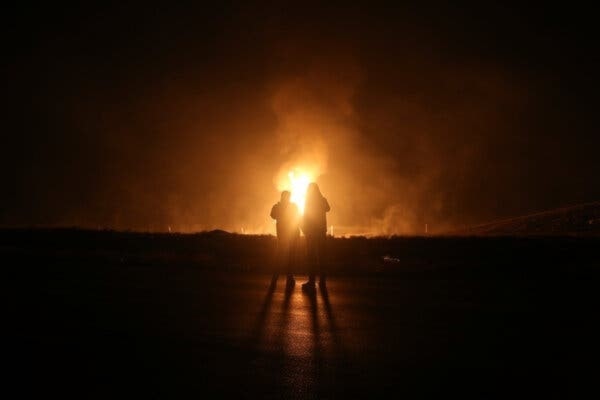'Israel' behind attack on Iranian gas pipelines, NYT claims
One Western official tells The New York Times the strikes were major and symbolic, but their damage was relatively easy for Iran to repair and caused minimal harm to civilians.
-

Two people stare at flames from the explosion at the site of one attack, in Chahar Mahal Bakhtiari, Iran (Reza Kamali Dehkordi/Fars News Agency, via Associated Press)
Israeli occupation forces launched attacks that targeted Wednesday two vital gas pipelines within Iran, disrupting the supply of heat and cooking gas to Iranian provinces with millions of residents, The New York Times reported citing two Western officials and a military strategist associated with Iran's Islamic Revolution Guard Corps (IRGC).
Iranian Oil Minister Javad Owji previously described the incidents as "sabotage and terrorist attacks," and pointed out on Friday that "the enemy’s plan was to completely disrupt the flow of gas in winter to several main cities and provinces in our country."
The Western officials and the Iranian military strategist highlighted that the gas pipeline attacks reportedly carried out by "Israel" required in-depth knowledge of Iran's infrastructure and precise coordination, considering that two pipelines were simultaneously targeted in multiple locations.
According to one Western official who said the strike was major and symbolic, the damage was relatively easy for Iran to repair and caused minimal harm to civilians, but delivered a clear warning of the potential damage "Israel" could cause amid escalating conflicts in the Middle East and heightened tensions between Iran and the Israeli occupation and the United States.
The New York Times cited Western officials as saying that "Israel" was also responsible for a separate explosion on Thursday in a chemical factory on the outskirts of the Iranian capital Tehran, causing disturbance in the neighborhood and sending smoke and fire into the air. However, local officials mentioned that the factory explosion resulted from an accident in the fuel tank.
The attack on Wednesday targeted multiple points along two main gas pipelines in the Iranian provinces of Fars and Chahar Mahal Bakhtiari, and according to Iranian officials and local media, the disruption extended to residential homes, government buildings, and major factories, affecting at least five provinces across the country.
NYT emphasized that these pipelines transport gas from the south to main cities such as Tehran and Isfahan, with one pipeline reaching Astara, a city near Iran's northern border with Azerbaijan.
The newspaper cited energy experts as saying that the attacks, spanning approximately 1,200 kilometers or 800 miles each and carrying 2 billion cubic feet of natural gas per day, resulted in the shutdown of around 15% of Iran's daily natural gas production.
Saeid Aghli, an official with the Iranian national gas company, told local media that the attack was aimed at disabling about 40% of the country’s gas transmission capacity.
But Iranian Oil Minister Javad Owji confirmed on Friday that technical teams from the ministry had tirelessly worked to repair the damage caused by the blasts, affirming that the disruption had been minimal, and normal service had been restored.
The method used to target the pipelines, whether through drones, explosives attached to pipes, or other means, remains unclear, The New York Times noted.
According to NYT, the military strategist associated with the IRGC claimed that "the Iranian government believed Israel was behind the attack because of the complexity and scope of the operation," and that the sabotage "almost certainly" required agents in Iran to determine the precise locations and methods for the strike.
The strategist mentioned that the main pipelines in Iran, responsible for transporting gas across extensive and diverse terrains, including mountains, deserts, and rural fields, are regularly patrolled by guards stationed at outposts along their length.
He added that the guards conduct checks in their designated areas every few hours. Therefore, "the attackers may have had knowledge of their breaks, when the area would remain unmanned."
Read more: 'Iran leaving fingerprints everywhere' has become a curse for US: WSJ

 4 Min Read
4 Min Read








